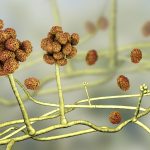Toxoplasma Gondii: A Mind/Body Parasite?
Kurt Beil, ND, LAc
Toxoplasma gondii is a single-celled protozoal parasite of the phylum Apicomplexa. It is perhaps best known as “that thing you get from the cat’s litter box,” as a pregnant mother once said. It is a source of concern for expectant mothers and other populations, some of whom are only recently coming to light. In fact, you may be surprised to learn what potential fate might lie waiting in a cat’s private commode.
Introduction
Detected for the first time in Africa in 1908, T. gondii has since been found throughout the world. It occurs quite commonly in the human population: 60 million Americans are currently thought to harbor this protozoa (Jones et al., 2003). Most individuals (80%-90%) will remain asymptomatic and never know they have it. Occasionally a healthy person can manifest swollen lymph nodes, vague muscle and/or joint pain, and generalized malaise or fatigue. These flu-like symptoms are typical of almost any mild infection and are rarely investigated further. They are certainly not pathognomonic for T. gondii.
More serious sequelae arise in certain populations, such as the fetuses of expectant mothers. Congenital toxoplasmosis is a very serious concern and can cause miscarriage or stillbirth, as well as deafness, seizures, chorioretinitis, hydro- or microcephaly, cerebral palsy and other types of brain damage (Mahon and Manuselis, 2000). For these reasons, expectant mothers are given the TORCH panel to screen for Toxoplasma (as well as rubella, cytomegalovirus, herpes and other potentially complicating congenital infections). Individuals with suppressed immune systems are also at risk of developing toxoplasmosis. In such persons, infection can result in severe infections of the eyes, lungs and central nervous system (CNS). Toxoplasmic encephalitis is the most common of these complications, and can result in seizures, paralysis, loss of balance, parasthesia, disorientation, agitation, delusions, hallucinations, psychosis and, ultimately, death (Luft and Remington, 1992).
Infectious Schizophrenia?
It is these last few psychotic symptoms that currently are of interest to the international world of microbiology research. Though the neurological manifestations of T. gondii infection have been known since the 1950s (Minto and Roberts, 1959), until now they have been thought only to affect the susceptible at-risk populations, causing most doctors to overlook the possible association of symptoms in the general population. However, recent studies suggest that infection with T. gondii may affect adults with a healthy immune system. Though the evidence is far from conclusive, this is a source of potentially serious medical concern, considering the prevalence of Toxoplasma in our society. There is speculative research showing that the infection, which is able to lie dormant for decades, may play an insidious role in the progression and manifestation of schizophrenia (Mortensen et al., 2007).
First, to allay some fears, there is little evidence that suggests T. gondii causes schizophrenia. This psychotic disorder is thought to be a combination of genetic, experiential, biological and environmental factors. The delusions, hallucinations, disorganized thoughts, speech and behaviors, and flat or negative affect that identify this disorder (American Psychiatric Association, 2004) have not been considered to have an infectious etiology since before the invention of modern psychology. To suggest that schizophrenia might somehow be “acquired” hints back to pre-Freudian notions of madness as a form of spiritual or demonic possession, and is generally not considered a viable hypothesis in today’s medical community.
The literature does suggest that it would be possible for T. gondii to facilitate psychotic episodes in people with genetic and other schizophrenic predispositions. As T. gondii parasites invade a new host, they travel to the CNS and encyst or become dormant. Through an unknown mechanism, these dormant cysts disrupt the functioning of certain neurotransmitters, particularly dopamine (Skallová et al., 2006). Over time, this disruption could theoretically damage an already susceptible system and result in the disorganized thoughts, hallucinations and delusions typical of schizophrenia.
In my opinion, the evidence for Toxoplasma’s supporting role in the pathogenesis of schizophrenia looks solid. Titer levels of IgG antibodies to T. gondii are consistently higher in populations of schizophrenic patients than in non-affected control populations (Torrey and Yolken, 2003; El-Sahn et al., 2005; Zhu et al., 2007). This relationship between increased titer levels and disease is known as “seroprevalence” and is related to “serointensity,” which correlates titer levels with severity of disease. A relationship of T. gondii serointensity and schizophrenia was found in a recent study, compared with no relationship in subjects with either major depression or non-expression of symptoms (controls) at the same institution (Hinze-Selch et al., 2007). Another study found higher levels of IgG antibodies for T. gondii associated with more severe psychotic symptoms in schizophrenic patients, as measured by ELISA and multiple-linear regression (Amminger et al., 2007). Post-toxoplasma exposure has even been shown to negatively correlate with patients’ behavior (Havlicek et al., 2001). Though none of these studies conclusively show causality, they establish a link between the empirical world of infectious microbiology and the ethereal realm of the conscious mind. This possibly gives new meaning to the concept of mind-body medicine.
Transmission of T. gondii
The only place T. gondii can reproduce is in the intestines of a cat. It is for this reason that cat litter is the commonly recognized source for Toxoplasma infection. Cat feces are the vehicle by which newly produced T. gondii are spread, either through primary fecal-oral ingestion or secondarily through meat from an animal that had ingested the feces. In fact, half of the cases of T. gondii in the U.S. occur from consuming infected meat. This is the third-leading cause of infected food-related mortality in the U.S. after Salmonella and Listeria, with approximately 350 deaths per year (Mead et al., 1997).
For people afraid of contracting the parasite from their cat’s litter box, most do not realize that a cat will only be a viable transmitter of infection if it has consumed an infected host, such as a mouse or bird. A housebound or declawed cat living off commercial cat food poses little danger in spreading the disease. As a result, only 1%-2% of our furry friends have been detected as carriers of T. gondii. Furthermore, the life cycle of Toxoplasma is such that virulence only occurs 24-36 hours after the organism has left the host’s gastrointestinal tract. This means that a freshly made stool from a cat cannot confer disease-producing T. gondii. Though the cysts may be present, they are not mature enough to cause disease, even in the immuno-compromised. Only if it is allowed to mature for a day or two is cat feces a risk. Finally, aerosolized T. gondii cannot be acquired by inhalation.
Crazy as (Cat) Poop
Given the occurrence of psycho-behavioral changes in populations at risk for T. gondii infection, the increased seroprevalence of T. gondii in the schizophrenic population and the known behavioral changes that T. gondii causes in rodents, it is safe to say that toxoplasmosis has an impact on the mind/body system. The full extent of this relationship will not be known without further research.
We know that an infected cat will shed T. gondii parasites. Infection by these parasites is linked to neuro-psychological symptoms, such as hallucinations and delusions. The severity of these symptoms is correlated with the serointensity of T. gondii, which is determined by density of cat feces exposure, and hence by the preponderance of cats. When one considers these factors, it seems possible that T. gondii has created a system that alters susceptible people’s behavior patterns in a way that facilitates their motivation to obtain as many cats as possible, perpetuating re-infection. With more cats in the proximal area, not only will opportunities for infection be greater due to increased fecal density, but chances that a specific fecal deposit will be overlooked for extended periods of time will be increased, allowing the cysts to mature, become viable and spread.
I would like to propose a speculative hypothesis: Evidence supports the growing theory that mentally unstable people who hoard vast numbers of cats, known in popular culture as the “Crazy Cat Lady” phenomenon, are victims of a T. gondii infection. The pathogenesis and evolution of this condition are currently unknown. More research needs to be applied in this area to determine if these individuals are infected with the T. gondii parasite, if they are particularly sensitive to T. gondii’s effects or show substantially increased serointensity, and if anti-parasitic protocols would be effective treatment for correcting unhealthy behavioral and/or personality changes in such individuals.
Prevention
Though the research is not yet conclusive for the exact role that Toxoplasma gondii plays in the onset of schizophrenia, no one should make an effort to house this parasite. Until more research is conducted to determine the extent that latent asymptomatic toxoplasmosis has on the general population, everyone should take simple measures to avoid contamination. As always, it is better to avoid contracting a disease than to fight it once it is acquired. See the accompanying sidebar for tips to help prevent Toxoplasma infection.
Tips for Preventing Toxoplasma Infection
Hygiene
- Always wash hands with soap and water before handling food.
- Wear gloves when doing outside gardening work, especially if cats are known to inhabit the area.
Food
- Avoid consumption of raw meat. Cook all meat appropriately.
- Wash all vegetables thoroughly.
- Rescind the food-on-the-ground “5-second rule,” especially if cats are known to inhabit the area.
Cats
- Make sure the cat’s litter box is cleaned daily. Wash hands thoroughly with soap and water afterwards.
- For patients in an at-risk group for acute toxoplasmosis, recommend that someone else change the litter box if possible. If this is not possible, suggest that patients wear gloves and wash hands immediately afterwards.
 Kurt Beil, ND, LAc is a dual-degree graduate of NCNM’s 50th anniversary class of 2006. He is currently pursuing a master’s of public health degree from Portland State University and maintains a private practice focusing on mind/body medicine and nature cure. His position as adjunct professor of microbiology at NCNM, as well as his background in evolutionary biology and psychology, were very useful in helping him write this article. He owns no cats.
Kurt Beil, ND, LAc is a dual-degree graduate of NCNM’s 50th anniversary class of 2006. He is currently pursuing a master’s of public health degree from Portland State University and maintains a private practice focusing on mind/body medicine and nature cure. His position as adjunct professor of microbiology at NCNM, as well as his background in evolutionary biology and psychology, were very useful in helping him write this article. He owns no cats.
Jones J et al: Toxoplasma gondii infection in the United States, 1999-2000, Emerg Infect Dis 9(11):1371-4, 2003.
Mahon C, Manuselis G: Textbook of Diagnostic Microbiology (2nd ed), Philadelphia, 2000, Saunders Co.
Luft BJ, Remington JS: Toxoplasmic encephalitis in AIDS, Clin Infect Dis Aug;15(2):211-22, 1992.
Minto A, Roberts FJ: The psychiatric complications of toxoplasmosis, Lancet 1:1180-2, 1959.
Mortensen PB et al: Early infections of Toxoplasma gondii and the later development of schizophrenia, Schizophr Bull May;33(3):741-4, 2007.
American Psychiatric Association: Diagnostic and Statistical Manual of Mental Disorders DSM-IV-TR (Text Revision), Arlington, 2004, American Psychiatric Association.
Skallová A et al: The role of dopamine in Toxoplasma-induced behavioural alterations in mice: an ethological and ethopharmacological study, Parasitology Nov;133(Pt 5):525-35, 2006.
Torrey EF, Yolken RH: Toxoplasma gondii and schizophrenia, Emerg Infect Dis 9(11):1375-80, 2003.
El-Sahn AA et al: Seropositivity of toxoplasmosis in patients with schizophrenia, J Egypt Public Health Assoc 80(5-6):509-24, 2005.
Zhu S et al: Epidemiological evidences from China assume that psychiatric-related diseases may be associated with Toxoplasma gondii infection, Neuro Endocrinol Lett Apr;28(2):115-20, 2007.
Hinze-Selch D et al: A controlled prospective study of toxoplasma gondii infection in individuals with schizophrenia: beyond seroprevalence, Schizophr Bull May;33(3):782-8, 2007.
Amminger GP et al: Antibodies to infectious agents in individuals at ultra-high risk for psychosis, Biol Psychiatry May 15;61(10):1215-7, 2007.
Havlicek J et al: Decrease of psychomotor performance in subjects with latent ‘asymptomatic’ toxoplasmosis, Parasitology 122:515-20, 2001.
Webster JP et al: Effect of Toxoplasma gondii upon neophobic behaviour in wild brown rats, Rattus norvegicus, Parasitology Jul;109(Pt 1):37-43, 1994.
Vyas A et al: Behavioral changes induced by Toxoplasma infection of rodents are highly specific to aversion of cat odors, Proc Natl Acad Sci USA Apr 10;104(15):6442-7, 2007.
Mead PS et al. Food-related illness and death in the United States, Emerg Infect Dis Sep-Oct;(5)5:607-25, 1999.









